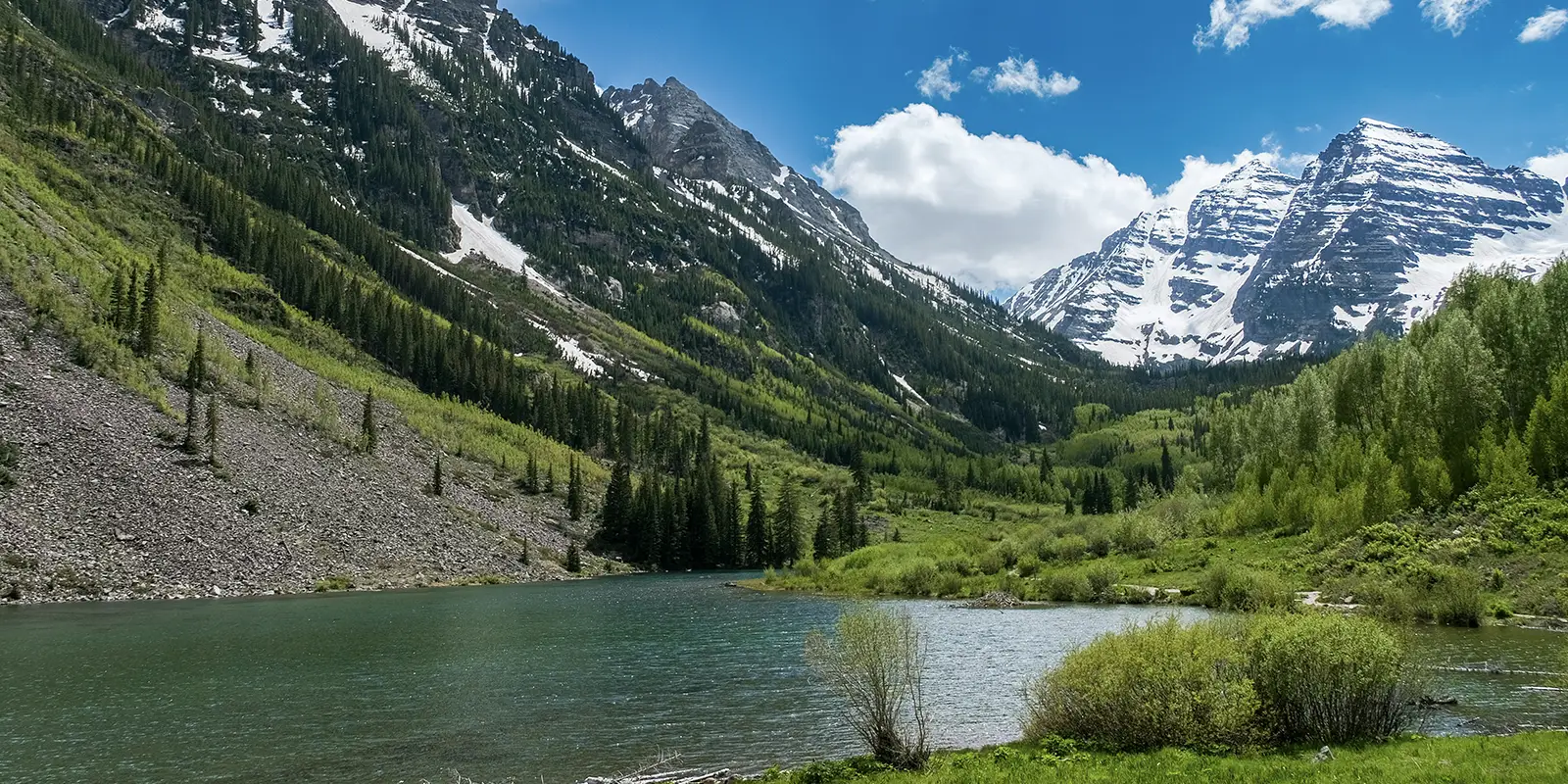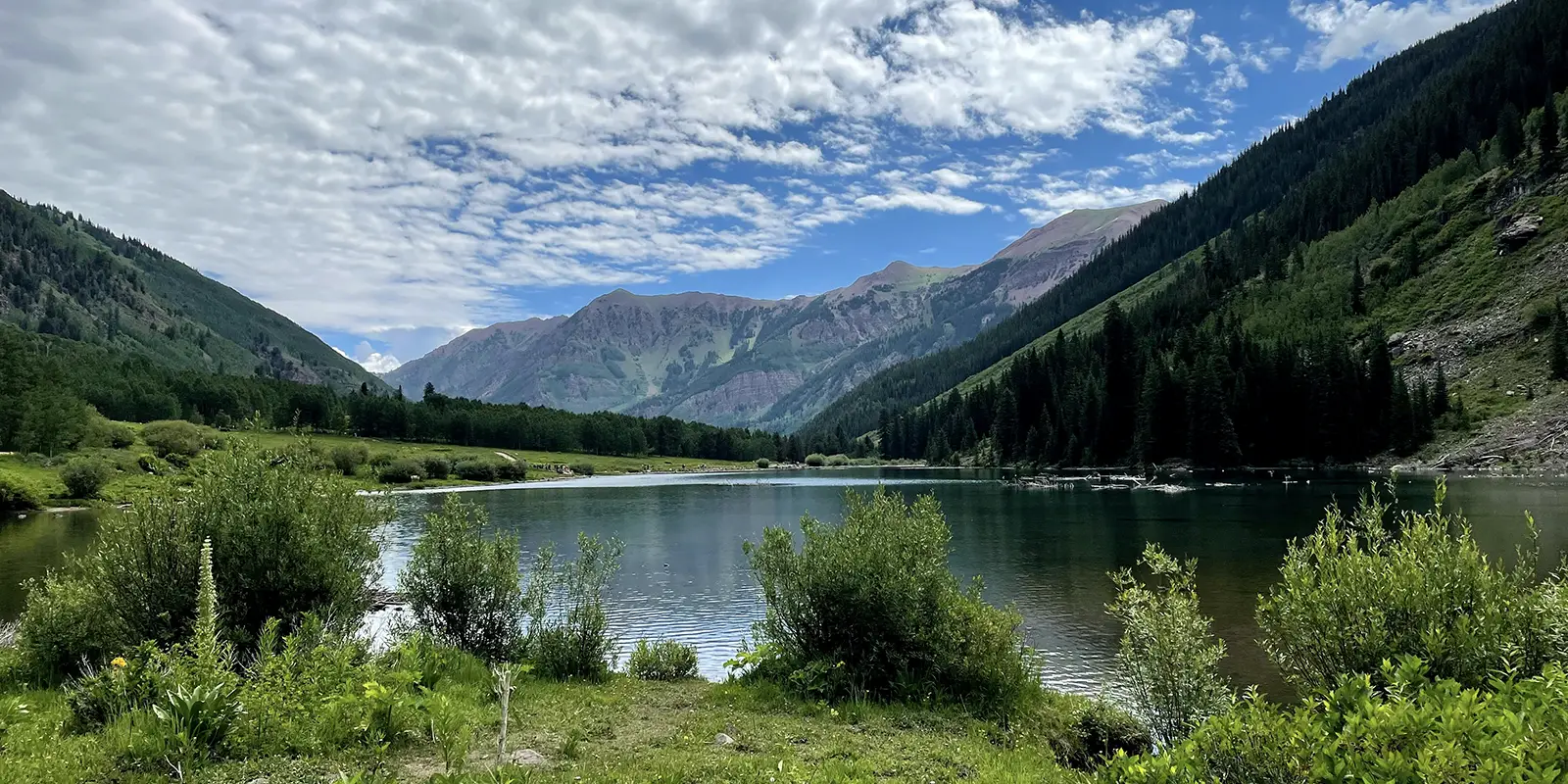Maroon Lake, southwest of Aspen, Colorado, is a breathtaking alpine lake in the Maroon Bells-Snowmass Wilderness. The majestic Maroon Bells, two of Colorado’s most iconic peaks, frame Maroon Lake and are beautifully mirrored in the lake’s clear, serene waters.
Surrounded by lush aspen groves and evergreen forests, Maroon Lake presents a stunning backdrop, especially in fall, when its foliage transforms into vivid gold and orange hues. Easily accessible via a scenic drive, Maroon Lake is a favorite spot for hiking, photography, and absorbing the indescribable beauty of the Rocky Mountains.
Where Is Maroon Lake Located?
Maroon Lake is located southwest of Aspen, Colorado, in central western Colorado. The Maroon Bells, two peaks in the Elk Mountains of the White River National Forest, rise up on the border of Pitkin and Gunnison counties, about 12-miles southwest of Aspen.
The nearest major city to Maroon Lake is Aspen, which can be reached by vehicle or a flight into the Aspen/Pitkin County Airport. To get to the Maroon Bells Scenic Area, go to Aspen and take Maroon Creek Road, which is in southwest Aspen. Parking at Maroon Lake is limited, especially during the summer and fall.
If the parking lot is full, you may need to use the shuttle service that runs from the Aspen Highlands area to Maroon Lake. Once you arrive, there are several hiking trails that start at the lake, offering stunning views of the surrounding peaks and forests.
Can You Drive to Maroon Lake?
Maroon Creek Road is open to vehicles during the summer months. It may have restrictions or be accessible only by shuttle in peak season.
Can You Go to Maroon Bells Without a Reservation?
The U.S. Forest Service manages the White River National Forest. It requires reservations to visit the Maroon Bells Scenic Area by car or shuttle from May 15 to October 31, in 2024. Make reservations through the Aspen Chamber Resort Association. Parking reservations cost $10 per vehicle and are available for day visits from 12 p.m. to 4:30 p.m., evening visits from 5 p.m. to 12 a.m., 24-hour visits, and 2-night overnight visits.
Walk-ups are welcome, but the Roaring Fork Transportation Authority (RFTA) Maroon Bells bus offers premier commuter tours to Maroon Bells. This route departs from the Aspen Highlands Visitor Center, where parking is available on weekdays. The Castle Maroon bus also runs from Aspen to Aspen Highlands every 20 minutes on the hour for no fare.
Visitors can find alternative transportation options outside of the RFTA’s regular shuttle hours, which provides transportation to Maroon Bells when the RFTA shuttle is not running. Fees vary according to the amount of time the tour takes, plus parking fees. For example, from three hours, three to eight hours, or 24+ hours, fees increase with the length of the tour.

When Are Reservations to Maroon Bells Not Required?
Reservations are not required to bike up the road to Maroon Bells. Biking is a popular way for locals to explore the area. Visitors can rent road bikes, cruisers, and e-bikes in Aspen.
Starting November 1, 2024, no reservations are required and trailhead parking will be first come, first serve. The road to Maroon Bells usually closes for winter around November 15, but it may close earlier due to snow.
Can You Swim in Maroon Lake?
No, swimming is prohibited in Maroon Lake. The Forest Service does not permit swimming, wading, boating, kayaking, and rafting in or on Maroon Lake to preserve its scenic nature and outdoor experience.
What Are the Best Hiking Trails Near Maroon Lake?
Visitors can access detailed trail information to Maroon Lake and Maroon Bells at the Aspen Chamber Resort Association, the main visitor center in Aspen. The following trail descriptions do not include the awe-inspiring vistas and amazing landmarks on these trails.
- Buckskin Pass: This is a strenuous 8.2-mile out-and-back trail at the foot of Maroon Lake. Follow the Maroon-Snowmass Trail along Maroon Lake’s northern/right shore to a junction at the Deadly Bell’s Kiosk near the head of the lake.
- Crater Lake Trail: This moderate trail begins at Maroon Lake 10 miles up Maroon Creek Road. The left/scenic trail follows a river and crosses two bridges, then climbs steeply to meet with the Maroon-Snowmass Trail. The Aspen Center for Environmental Studies (ACES) leads daily FREE guided tours around Maroon Lake and to Crater Lake.
- East Maroon Trail: This trail is a mix of easy and moderate terrain and 8.5 miles one way:
- Maroon Lake Scenic Trail: The trail follows the creek flowing into Maroon Lake. This easy 1.3-mile trail is popular for pictures and picnics.
- West Maroon Pass: From the top of this pass, this 6.2-mile trail descends to the Frigid Air Pass and Schofield Park out of Crested Butte. The hike to Crested Butte is about 12 miles. The top of the pass is tricky and steep, plus it can be slick if the trail is wet.
- Willow Lake Trail: Follow the directions to Crater Lake. At the Crater Lake bulletin board, take the right fork. This strenuous 6.5-mile trail ascends steeply. The Maroon-Snowmass and Willow Lake trail junction is about a 0.5-mile hike above the tree line. From the top of the pass, the trail descends to the junction with the East Snowmass Trail. At the junction, take the right fork.
Are There Camping Options Near Maroon Lake?
The Forest Service requires a permit for overnight stays in the Maroon Bells-Snowmass Wilderness Overnight Permit Zones. Campers must acquire permits in advance through recreation.gov. For overnight trips outside of the permitted zones, self-registration is required at the various trailheads.
When Is the Best Time to Visit Maroon Lake?
The best time to visit Maroon Lake in Colorado is subjective. From late May to early October, the snow gives way to the landscape full of wildflowers and greenery. Wildflowers put on a show of vivid display in late June and early July. September boasts loudly with bright fall foliage. Fall is the busiest season at Maroon Bells, and visitors need to book reservations early.







